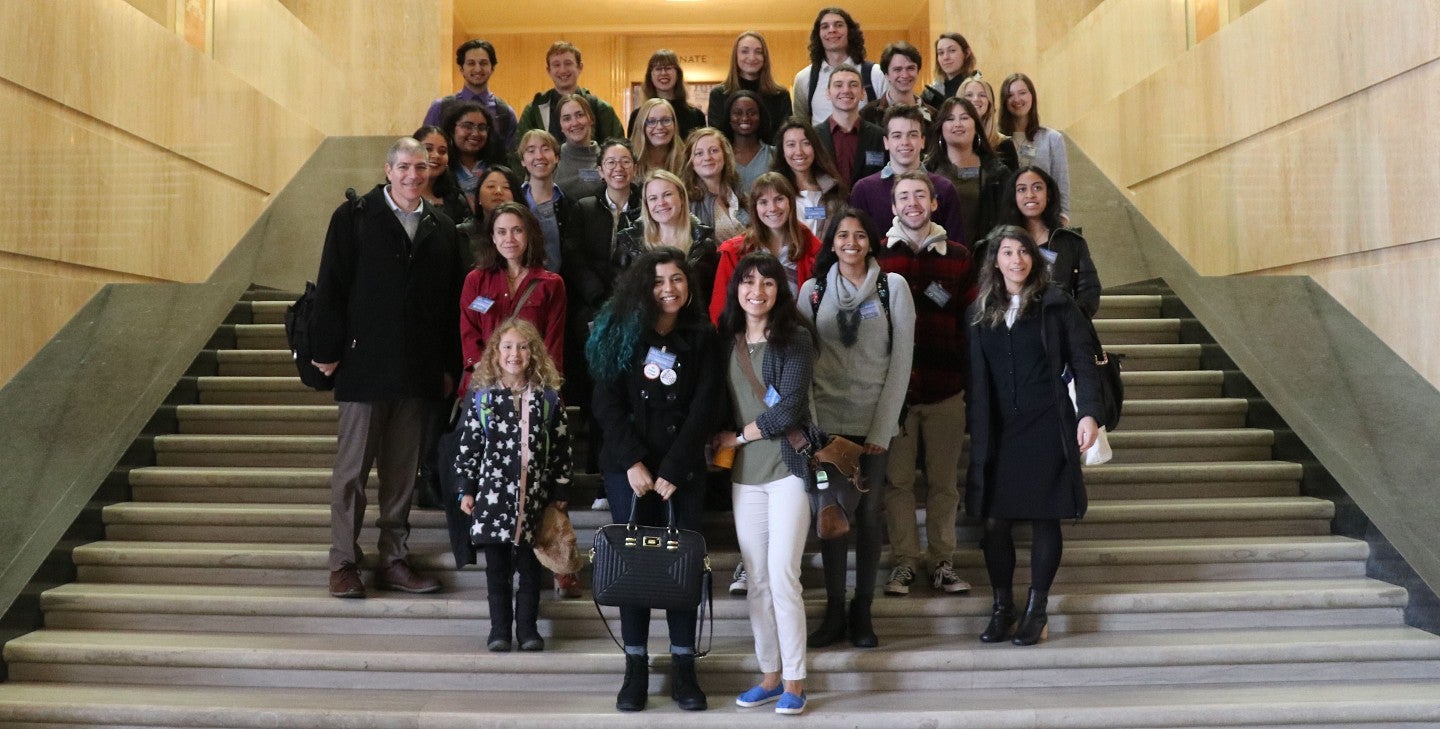
Program for Democratic Governance
The Program for Democratic Governance supports scholarly inquiry and educational programming on democratic institutions, behavior, and dilemmas. Begun in 2008 by Philip H. Knight Chair and founding Director Daniel Tichenor, the program is home to the Center’s Public Affairs Speaker Series (PASS) and Wayne Morse Scholars.

Wayne Morse Scholars
Wayne Morse Scholars is a program for undergraduate students interested in public policy, governance, and activism. All current UO students (not incoming freshman) are eligible to apply. Applications will be available in the spring.
2022-23 Public Affairs Speaker Series
Past Public Affairs Speaker Series events
2021-22
Oct 28
Immigrant Oregon Panel Discussion7:00 p.m.
This event is subject to UO COVID guidelines; refer to the UO COVID-19 Resource page for more details. Please register for this event to be notified of any...
Nov 9
Citizenship Reimagined: Race, Immigration, and the New States' Rights6:00 p.m.
Join us in person or online for this event. This event is subject to UO COVID guidelines; refer to the UO COVID-19 Resource page for more details. Please register for...
2020-21
Jul 28
Black Mental Health Matters4:00 p.m.
Watch live on Facebook At a moment of urgent racial reckoning, this program will explore the significance of Black mental health and ask what role it plays in the movement...
Oct 20
Defending Democracy: A Conversation with Eric H. Holder, Jr., 82nd Attorney General of the United States (2009-2015)noon
Register for this free event A leading progressive voice, Eric Holder has been instrumental in shaping the direction of the United States on a number of critical...
Oct 29
Facts Still Matter: Countering the Influence of Russian Hackers, Trolls, and “Viral Deception"4:00 p.m.
Featuring Kathleen Hall Jamieson, director of the Annenberg Public Policy Center at the University of Pennsylvania and cofounder of FactCheck.org. Register...
Nov 11
The State From Below: Democracy and Citizenship in Policed Communities4:00 p.m.
Register for this free event Vesla Weaver is the Bloomberg Distinguished Associate Professor of Political Science and Sociology at Johns Hopkins University....
2019-2020
Nov 20
A Good Provider is One Who Leaves: One Family and Migration in the 21st Century6:30 p.m.
Featuring Jason DeParle, two-time Pulitzer Prize finalist. His new book, A Good Provider is One Who Leaves, tells the story of an unforgettable family as they...
Jan 23
Political Discussion Networks, Political Engagement, and the Latino Electorate4:00 p.m.
Featuring Marisa Abrajano, professor of political science at the University of California, San Diego. Her research interests are in American politics, particularly in...
Feb 5
Women Voters: Race, Gender, and Dynamism in U.S. Presidential Elections6:30 p.m.
Featuring Jane Junn, University of Southern California. Jane Junn is a professor of political science and gender and sexuality studies at the University of Southern...
Feb 27
How We Became Our Data: A Genealogy of the Informational Person6:30 p.m.
Featuring Colin Koopman, associate professor of philosophy and director of the New Media and Culture Program at the University of Oregon. His books include: Pragmatism as...
May 1
A Conversation w/ Robert Kuttner on Saving our Economic Future4:00 p.m.
Join us for an online discussion and Q&A with Robert Kuttner, co-founder of the Economic Policy Institute and current editor of The American Prospect. Kuttner was a longtime...
2018-19
Oct 11
Women and the 2018 Midterm Elections6:30 p.m.
Featuring E.J. Graff, senior fellow at the Schuster Institute for Investigative Journalism. Graff researches and reports on gender and sexuality issues and is a board...
Oct 25
War and the Media: 1960s to the Trump Era6:30 p.m.
Featuring Norman Solomon, journalist, activist, and author. Solomon is co-founder of RootsAction.org and founding director of the Institute for Public Accuracy,...
Nov 12
Game Change or More of the Same? Assessing the Midterm Election6:30 p.m.
A discussion featuring Alison Gash, UO Political Science; Margaret Hallock, Wayne Morse Center; Jeff Mapes, OPB; and Kerry Tymchuk, Oregon Historical Society. Alison Gash...
Feb 27
The Known Citizen: Exploring Privacy in Modern America6:30 p.m.
Featuring Sarah E. Igo, history professor, director of the American studies program, and faculty director of the E. Bronson Ingram College at Vanderbilt University. Igo's...
Mar 12
Rivalry and Reform: Presidents, Social Movements, & the Transformation of American Politics6:30 p.m.
Sidney Milkis, University of Virginia politics professor, and Dan Tichenor, Wayne Morse senior faculty fellow, will discuss their forthcoming book.
Apr 18
Populism for the 1%: The Fall of the Republican Party and the Rise of Donald Trump6:30 p.m.
Featuring Paul Pierson, political science professor at UC Berkeley. His most recent books are The Transformation of American Politics: Activist Government and the Rise...
Apr 22
The U.S. Economic Outlook: Do Deficits Matter?7:00 p.m.
The University of Oregon invites you to hear from guest speaker Keith Hall, director of the Congressional Budget Office, with remarks from Sarah Nutter, dean, Lundquist...
May 7
Hope in Challenging Times: How cities—and people—lead the way in tackling our toughest issues6:30 p.m.
Featuring Cecilia Muñoz, vice president for public interest technology and local initiatives at New America. Prior to joining New America, she served for eight...
2017-18
Feb 6
America First?: Isolationism and Global Engagement in Historical Perspective6:30 p.m.
Guest speaker Christopher Nichols is the director of the Oregon State University Center for the Humanities. Nichols specializes in history and its relationships with...
Apr 5
The Origins of Today’s Radical Right and the Crisis of Our Democracy6:30 p.m.
Guest speaker Nancy MacLean is an American historian and the William H. Chafe Professor of History and Public Policy at Duke University. Maclean’s research focuses on race,...
Apr 17
Black Lives Matter and American Racial Politics6:30 p.m.
Guest speaker Alvin Tillery is an associate professor and associate chair of political science and African American studies at Northwestern University. His interests include...
2016-17
Oct 25
Ready for Hillary? Gender & Media in the Presidential Campaigns6:30 p.m.
Featuring Regina Lawrence, nationally recognized authority on political communication, civic engagement, gender and politics, and the role of media in public discourse about...
Nov 15
Challenges for the New Administration7:00 p.m.
Featuring Robert Kuttner, cofounder and coeditor of The American Prospect. He was a longtime columnist for Business Week, and continues to write columns in...
Mar 8
Checks & Balances in the Age of Trump7:00 p.m.
How well does our constitutional democracy work when one party controls the levers of power and crucial rights are at stake? This panel will try to answer this question...
2015-16
Jan 26
Access and Higher Education4:00 p.m.
Featuring UO President Michael Schill. Schill became the 18th president of the University of Oregon in 2015. He previously served as the dean and Harry N. Wyatt...
Feb 18
Racial Categories and Statistics: Can we achieve justice without them?6:30 p.m.
Featuring Kim Williams, Portland State University. An associate professor of political science at PSU, Williams also directs the Center for Women, Politics & Policy...
Apr 25
Calm Before the Storm: Oregon and National Campaigns at Halftime6:30 p.m.
Join us for a panel discussion featuring a great lineup of political experts: Betsy Boyd, Assoc. VP of Federal Affairs, University of Oregon. Before joining UO in 2000,...
May 23
Thunder on the Left and Right: Populism in the 2016 Elections6:30 p.m.
Series focused on the 2016 election. Join us as we explore the meaning and context behind the glitz and headlines in a dramatic election year. We’ll be...
2014-15
Oct 16
Surveillance, Suppression, and Secrecy7:00 p.m.
Featuring Nadine Strossen, former president of ACLU. Nadine Strossen is a professor of law at New York Law School. She served as president of the ACLU from 1991-2008 and is a...
Jan 20
The Revolt of the Cities: Transforming Urban Politics7:00 p.m.
Featuring Harold Meyerson, editor-at-large of The American Prospect and weekly columnist for The Washington Post. In 2009, he was named one of "the most...
Feb 5
His Own Received Him Not: Jimmy Carter, Progressive Evangelicalism, and the Religious Right7:00 p.m.
Featuring Randall Balmer, Dartmouth College; part of the Public Affairs Speaker Series.
Feb 10
Lessons in Leadership3:30 p.m.
Featuring Kerry Tymchuk, executive director of the Oregon Historical Society. Part of the Public Affairs Speaker Series.
Mar 10
We're Free, But Not *Free*: Custodial Citizenship in Our Time7:00 p.m.
Vesla Weaver is an assistant professor of political science and African American Studies at Yale University. She received her doctorate in Government and Social Policy at Harvard...
2013-14
Nov 14
Dollarocracy: The Money and Media Election Complex That is Destroying America7:00 p.m.
Featuring Robert W. McChesney and John Nichols, authors of Dollarocracy: The Money and Media Election Complex That is Destroying America. In addition to Dollarocracy, McChesney...
Feb 5
Toward More Perfect Unions: The Consequences and Possibilities of Marriage Equality4:00 p.m.
Featuring Beatrice Dohrn, Director Nonprofit Clinic, UO Law School, Alison Gash (UO Political Science), Ellen Herman (UO History). Part of the "We the People? From Seneca...
Mar 6
New Media, Race, and Participatory Politics: Democracy in the 21st Century5:00 p.m.
Featuring Distinguished Speaker Cathy Cohen, University of Chicago Department of Political Science. Cathy J. Cohen is the David and Mary Winton Green Professor of Political...
